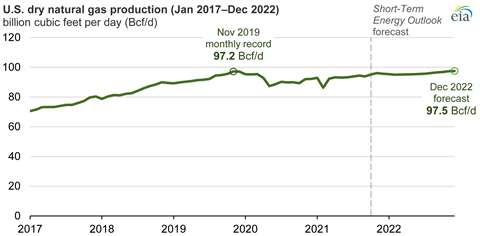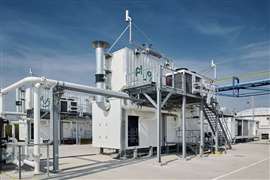U.S. gas production expected to climb in 2022
20 December 2021

U.S. natural gas production will continue to gradually increase as the industry continues to recover from the impact of COVID-19 and in response to additional drilling activity in key basins. Dry natural gas production will increase from 95.1 billion cubic feet per day (Bcf/d) in October to 97.5 Bcf/d in December 2022, according to the latest forecast from the U.S. Energy Information Administration.
The agency’s latest short-term energy outlook predicted that U.S. gas production in December 2022 will surpass the previous monthly record of 97.2 Bcf/d set in November 2019.
U.S. gas production took a severe hit in early 2020, when COVID-19 associated declines indemand led to a decrease in price and drilling activity. As a result, monthly natural gas production declined to a low of 87.3 Bcf/d in May 2020. Dry natural gas production in the United States has generally risen since then, with a brief exception in February 2021, when a brutal storm in Texas caused abrupt production shortages and price spikes.
The latest EIA production forecast noted that U.S. natural gas production has grown in recent months from additional natural gas-directed drilling activity and from additional natural gas production associated with oil production. That growth has been evident in both the Haynesville, which includes northeast Texas and Louisiana, and the Appalachian Basin, which includes Pennsylvania and West Virginia. Associated natural gas production has also increased as producers have completed wells that were previously drilled but uncompleted (DUC), the EIA reported.
The number of natural gas-directed rigs—rigs drilled primarily in natural gas-bearing formations—decreased throughout 2019 and the first half of 2020, based on data from the Baker Hughes Company. By late August 2020, the natural gas-directed rig count had fallen to 68 rigs, the fewest in Baker Hughes’s data series, which dates back to 1987.
The number of natural gas-directed rigs has since increased to 102 in mid-November 2021. Rig counts are considered a leading indicator of newly drilled wells, but increases in drilling efficiency (the number of new wells each rig can drill) and new-well production have complicated the relationship between rig counts and eventual production, the EIA reported.





